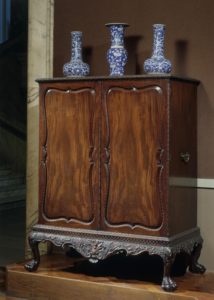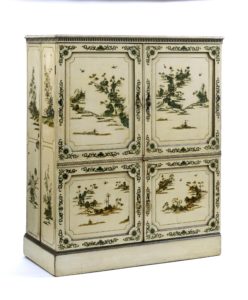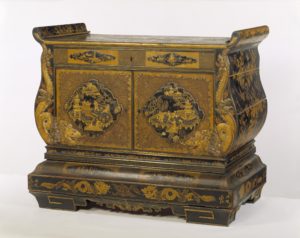One of the questions I get a lot when giving clothing workshops is “How did people store their clothes”? The answers are obviously very different across the classes, but in general my audience wants to know about the gentry and nobility.
Let’s start with closets. Yes, closets existed. Both in the modern sense of a large cupboard in which you store things and in the more historical sense of “a smaller room off a main living space, where you also stored things”. You see modern-type built in closets in many period homes, though they’re often hidden. They usually flank fireplaces, doorways, or built-in nooks for beds. The period idea of a closet was part of a suite of rooms that made up a person’s private chambers. There would be a bedroom, a study or boudoir, and often a closet or dressing room. This all varied widely so there’s no hard and fast rule as to what set-up your characters might have (and don’t forget to take in the era in which the house was built).

Mahogany clothes press, c. 1730-1760. Interior contains both drawers and shelves. Victoria and Albert Museum.
Regardless of what rooms your house has, the clothing storage will be of three types: chests (the classic flip-top large box), chest of drawers (just like today) and the clothes press/wardrobe (not like the big one that leads to Narnia). Clothes presses are most similar to what Americans now call “high boys” (which are a form of raised clothes press).

Clothes Press, c.1775-1778, Chippendale. Interior contains both shelves and drawers. Victoria and Albert Museum.
Clothes presses have drawers at the bottom and then an open space with pull-out shelves at the top behind doors. Later on (late 19thC) you get the kind with half the space given over to hanging garments and half to shelves). So your clothing would be carefully folded and organized among these various options, but in general it would not be hung as it often is today (I’ve heard their might have been pegs or a line for awkward items like false rumps, hoops, etc., but I’ve never seen this in practice outside of satirical drawings of how the poor lived).

Japaned Clothes Press, c. 1815, Crace (likely made for Brighton Pavilion). Victorian and Albert Museum.
It’s also likely that clothes were cycled, so you didn’t have everything in your room at once, just the things you needed for the season you were in. Clothing for other seasons would be packed away and stored in the attics (hence the treasure troves occasionally unearthed ). At the end of each season, you would decide what was worth packing away for use the next year and what you would get rid of (this retired clothing was generally a perq of the lady’s maid, who could refashion it for her own use or sell it).
For more insight into period homes, I highly recommend Georgian & Regency Houses Explained by Trevor Yorke.


Interesting post, Isobel! I do think people forget that hanging clothes up as we do now is a later practice. And now I want to check out Trevor Yorke’s book, which sounds lovely. Thanks for sharing!
They definitely hung things in shops when they were for sale (you see this in a lot of prints, with wares displayed on the walls), and they hung coats/cloaks on pegs in clubs, but hangers are Victorian. Clothes presses were sometimes reworked into what we think of wardrobes with a rod replacing the shelves so the furniture can be confusing too.
Fascinating post, Isobel. My brothers and my mother had huge wardrobes in their bedrooms in the house we lived in in England. They appeared to be fitted for hanging in design and each had a huge drawer at the bottom. In my room, however, I had something very like the last photo in this post. I was only nine when we moved there so it didn’t bother me. I just folded everything up. But my mother made my father fit a shower curtain rod across one corner of my room so she could hang up my dresses. We rented the house furnished, but looking back there were several pieces I really wish we could have brought home with us!